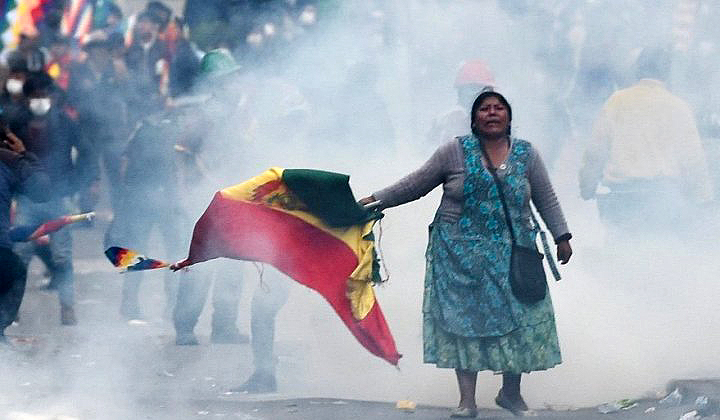
Above Photo: Repression in Bolivia during the Anez dictatorship.
October 20 Bolivia will mark two years since what became the preamble to a violent and bloody coup d’état against former president Evo Morales (2006-2019). On that day, as the people went to the polls to re-elect the indigenous leader, the most extremist fringes of the country’s right-wing began maneuvering from behind the scenes to overthrow the government.
The story of what happened after Election Day is well known. The Organization of American States (OAS) insisted that Morales’ new victory was the result of widespread electoral fraud -although it had no evidence-, thus paving the way for the opposition to take over the Palacio Quemado, the government headquarters.
The sequence of images that followed these events is even more perverse: local and foreign right-wing media promoted discrediting campaigns against the constitutional government, the Army Chief of Staff “invited” the Uru-Aimara leader to abandon power, thousands of people in the streets against the coup were victims of bullets and blows, a senator proclaimed herself president, a photograph immortalized her, all smiling, receiving the help of a soldier to put on the presidential sash.
The first dictator in history, Jeanine Añez, took the reins of Bolivia shortly before the first cases of COVID-19 arrived in the country.
Bolivia, which used to be admired in the region for its illiteracy reduction, infrastructure growth, and poverty decline, saw each of these achievements collapse in a matter of months.
Since November 2019, there started to grow corruption scandals that involved the leaders of the coup-born regime, allegations of dozens of assassinations, and critics for the mismanagement of the pandemic.
Añez did not train health personnel to face such a contagious and deadly virus. She was corrupt and ruthless. She established violence and racism, imposed a fascist curfew, and militarized the streets to prevent people from leaving their homes, even knowing that most had no money or food to survive the quarantine.
Many families were scarred due to the oppression and extremism rained down on them. In those days of pain, it was common to hear devastating stories, like that of a 12-year-old girl who committed suicide because of the hunger she, her siblings, and her mother were facing at home.
Just one year after the coup, in November 2020, “the savages,” as Añez called the socialist government, returned to power under the leadership of Lucho Arce. Evo returned from Argentina, while many coup leaders fled, and others faced justice for their crimes.
Añez, who’s seen in some power circles as a heroine, is currently serving time for terrorism, sedition, and conspiracy. “No sentence is enough to do justice for the 36 fatalities, the more than 800 people wounded, and the over 1,500 persons illegally detained during her regime,” Evo said.
Bolivia cannot forget. The Movement Towards Socialism (MAS) continues to be implacable with the perpetrators and accomplices of the dictatorship that plundered the economy and attacked the democracy of a humble country. Today, Bolivians are confident that history will not repeat itself.
Related posts:
Views: 0
 RSS Feed
RSS Feed

















 October 22nd, 2021
October 22nd, 2021  Awake Goy
Awake Goy 


 Posted in
Posted in  Tags:
Tags: 
















